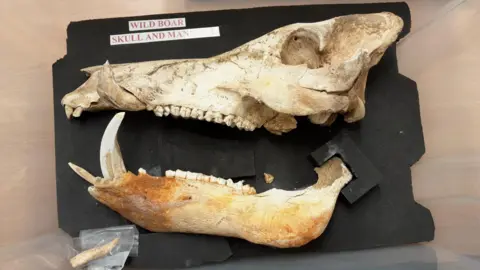In a remarkable archaeological discovery, remains of an extinct breed of Bronze Age cattle known as aurochs have been found in a cave in the picturesque Yorkshire Dales. This significant finding came to light thanks to a collaborative effort between archaeologists and cave explorers who were conducting a survey of various caverns and sinkholes in the Ingleborough area. The excavation team uncovered the remnants, which provide critical insights into the fauna that once roamed this region thousands of years ago.
The discovery is not only limited to the remains of the aurochs but also includes evidence suggesting that the site was utilized as a human burial ground during the Neolithic period. This revelation allows researchers to understand better how the caves and surrounding areas were utilized by inhabitants of the Dales long before recorded history. According to a spokesperson for the project, the findings have significantly illuminated the role of these caves, showing their importance to early agricultural societies.
Aurochs were majestic animals that once inhabited vast stretches across Europe before they faced extinction in the 17th century, largely due to habitat destruction and hunting pressures. These creatures are noteworthy because they are considered the wild ancestors of domestic cattle, making their remnants an invaluable window into agricultural ancestry. Archaeologists working in the region emphasize how the remains contribute to the broader narrative of human interaction with the landscape and indicate a long-standing relationship between early communities and their environment.
The excavation forms part of an extensive initiative dubbed the Ingleborough Cave Archaeology Project, which is included in a £3 million investment from the National Lottery Heritage Fund. This scheme is focused on preserving the future of upland commons in the Yorkshire Dales, as well as other English regions like Dartmoor, the Lake District, and the Shropshire Hills. The investigation showcases the essential role that experienced local cavers play in bringing to light hidden historical artifacts, especially as some cave sites necessitate specialized skills for access.
Rick Peterson, a caving archaeologist associated with the University of Central Lancashire, highlighted the importance of local knowledge, noting that it is often these skilled amateur cavers who first encounter significant archaeological finds. Their collaboration with professionals ensures that every discovery made during recreational caving activities is properly documented and preserved for future study.
Furthermore, the project extends its scope beyond archaeological exploration, as it also seeks to engage contemporary farmers in sustainable land management practices that would protect the region’s agricultural heritage. Notably, Ingleborough is one of the few areas in England where traditional “commoning” practices continue to thrive, with a small number of farmers still utilizing rights that date back to the Magna Carta for grazing livestock on common land.
Claire Braeburn, the project officer, elaborated on the importance of their findings concerning common land usage, as It was revealed that a significant portion of England was once common land but has now dwindled to just 3%. The current findings from the caves provide a glimpse into how long humans have engaged in agricultural practices on these lands, emphasizing the need to preserve these ancient customs, lest they vanish entirely.
The ongoing project not only addresses the past but also advocates for the preservation of the biodiversity and agricultural traditions that have shaped human life in this unique environment. The insights gained from the project thus far illustrate the intricate link between historical agricultural practices and the sustainability efforts needed for today’s and future generations.
Ingleborough’s caves are now recognized not just as archaeological sites but as vital repositories of history that could provide context to the ongoing evolution of farming and land management in England. Through the partnership between archaeologists and cavers, these efforts will ensure that the invaluable history of the Yorkshire Dales remains accessible and understood for generations to come.












